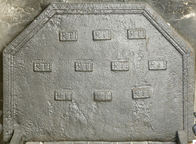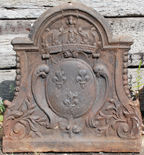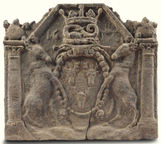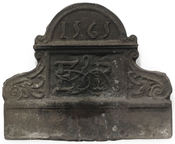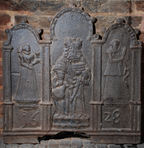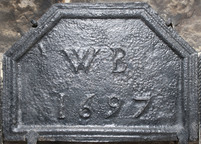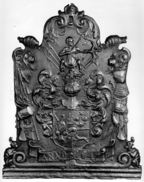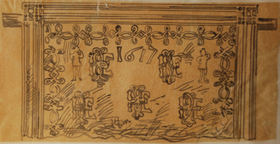-
277
Description: Arched rectangular with cavetto-moulding along top, supported by Ionic pilasters; English Stuart royal shield, garter, helm, crown, motto and supporters; date below and either side of garter.
Notes: One of several firebacks, all of the same date, but varying in size, framing style and moulding; all have stylistic features in common and will have been the work of the same pattern maker, who was also responsible for carving royal coats of arms in three West Country churches. Mendip Auctions, Binegar, 11 Dec 2021, lot 537.
Copies of this fireback are known.
Inscription: I R [Jacobus Rex] / HONI SOIT QVI MAL Y PENSE / 16 18 / DIEV ET MON DROIT
Arms: English Stuart royal (James I)
- Decoration tags:
- rectangular with round arch (shape)
- complex individual (edging)
- whole carved pattern
- architectural
- armorial
- royal
- text
Manufactured: in 1618 possibly in the Forest of Dean area of England.
Current location: not known.
-
876
Description: Canted rectangle; complex moulded edging (top and sides); rectangular incised initial stamp repeated ten times 3-4-3.
Notes: The use of an incised stamp is uncommon.
Inscription: RTI [repeated 10 times]
- Decoration tags:
- rectangular with canted top corners (shape)
- complex individual (edging)
- carved stamps
- text
Manufactured: in the 17th century in England.
Current location: Westwood Manor, Bradford-on-Avon, Wiltshire, England.
Museum number: 222509.1 (part of the National Trust museum group)
- Attached to series:
- Initials only firebacks
- Miscellaneous stamp firebacks
-
850
Description: Canted rectangle; elaborate cavetto moulded edging (top and sides); strapwork shield with a demi-flower at each side, between initials (S only visible); arms quarterly of six, 1st Or two chevronels Gules, on a canton of the last a mullet of the first (Pope); 2nd Argent three bars Gules, on a canton ermine a bend of lozenges of the second (Walshe); 3rd Sable three laurel leaves in bend Or between two bendlets Argent (Waller); 4th Azure a chevron between three crosses Moline Argent (Lansdale); 5th Ermine on a bend Gules three lions’ heads erased Or (Weston); 6th Azure a lion rampant Or supporting a cross patée fitchée of the second (Pichingham).
Notes: The excrescence over the third quartering is the result of the iron being poured directly onto the mould. The second initial is known from another casting. The date above the shield has been inserted before casting and differs slightly from another example of the same back.
Copies of this fireback are known.
Inscription: 1625 / S [P]
Arms: Pope (Sackevile Pope (b. 1589) of Hendall, in Buxted, Sussex)
- Decoration tags:
- rectangular with canted top corners (shape)
- complex individual (edging)
- whole carved pattern
- date stamp
- armorial
- text
Manufactured: in 1625 in the Weald area of England.
Current location: not known.
- Attached to series:
- Personal armorial firebacks
- Low relief armorial series
-
243
Description: Upon a rectangular base plinth, wide scrolled side fillets with foliage about the scrolls and suspended bell flowers in chain above; central cartouche behind an oval shield bearing three fleurs-de-lys surmounted by a French royal crown; on top, an arch rising from horizontal moulding on each side.
Notes: Characteristic of designs illustrated by architects such as Daniel Marot.
Arms: French royal
- Decoration tags:
- rectangular with round arch (shape)
- complex individual (edging)
- whole carved pattern
- planklines
- armorial
- royal
Manufactured: in the late-17th to early-18th century in France.
Current location: not known.
Citation: Carpentier, H., 1912, Plaques de Cheminées (Paris, published by the author).
- Attached to series:
- Foreign armorial firebacks
-
246
Description: Quasi-arched rectangular shape; on a ground, an armorial achievement comprising a central cartouche on which is an oval shield bearing the arms of the Cavendish family, with graduated bead edging; supporters, two stags rampant; above the cartouche, on a wreath a coiled snake crest surmounted by an earl’s coronet; the date split either side of the crest; to each side, a column with foliate capital supporting a three-sided arch with ovolo-moulded edging, on each shoulder of which is a flaming orb.
Notes: The arms are those of William Cavendish, 3rd Earl of Devonshire (1617-84). Sotheby's auction, The Chatsworth Attic Sale, 7 Oct 2010, lot 3 (£18,750).
Inscription: 1657
Arms: William Cavendish, 3rd Earl of Devonshire
- Decoration tags:
- rectangular with three-facetted arch (shape)
- complex individual (edging)
- whole carved pattern
- individual numbers
- armorial
- text
Manufactured: in 1657 in England.
Current location: not known.
- Attached to series:
- Personal armorial firebacks
- Cavendish arms series
-
261
Description: Plain rectangular bottom panel with fillet on top; above, rectangular panel with fillet and ovolo-moulded edging, within which the initials, ER, ornately carved, intertwined with floral tendrils; on each side, a scrolled bracket with double fillet edging, enclosing [?] ears of corn; on top, a narrow cornich, with an arch above, scrolled at each end and with double fillet edging, enclosing the date, possibly formed of individual stamped letters.
Notes: The 'ER' initials should not be assumed to be those of Elizabeth I. Formerly at Ockwells Manor, Cox Green, Berkshire. Christie's auction 4 Nov 2008 lot 259 (£3,750).
Copies of this fireback are known.
Inscription: 1565 / ER
- Decoration tags:
- rectangular with round arch (shape)
- complex individual (edging)
- whole carved pattern
- individual numbers
- text
- plants
Manufactured: in 1565 in the Weald area of England.
Current location: not known.
- Attached to series:
- Personal firebacks
- Date & initials firebacks
-
888
Description: Triple arched rectangular shape, centre arch higher; each arch supported by pilasters; within centre arch, cloaked, bearded male figure wearing a crown and carrying a ewer and what appear to be a pile of plates; in left arch, above first half of date, a clothed female figure carrying a goblet and possibly a candle on a staff; in the right arch, above the second half of the date, a clothed female figure holding a distaff and a length of wool; there is a narrow panel at the bottom; on the outside of the arches are scroll-shaped protusions.
Notes: The shape of this fireback is relatively uncommon, and the significance of the figures may relate to a particular narrative.
Inscription: 16 28
- Decoration tags:
- rectangular with three arches (shape)
- complex individual (edging)
- carved stamps
- whole carved pattern
- individual numbers
- architectural
- text
- humans
Manufactured: in 1628 possibly in the Eifel area of Germany.
Current location: in private hands, Cowden, Kent, England.
- Attached to series:
- Figurine firebacks
-
1112
Description: Canted rectangular shape; individual moulded edging; centre, initials WB, above date.
Notes: The text appears to have been imprinted into a mould formed from a base panel.
Inscription: WB / 1697
- Decoration tags:
- rectangular with canted top corners (shape)
- complex individual (edging)
- carved stamps
- individual letters
- individual numbers
- text
Manufactured: in 1697 possibly in the Weald area of England.
Current location: in private hands, Crowborough, East Sussex, England.
- Attached to series:
- Date & initials firebacks
-
1030
Description: Quasi-arched rectangular shape upon a moulded plinth; on a background comprising foliate swirls, a central shield, helm, coronet and elaborate mantling, with a crest of a forward facing centaur armed with a drawn bow pointed to the sinister side, and behind which are six pennons, three each side display in a v-shape; to the left, a triumph comprising a drum, draped flag on pole, concealing an arquebus, halberd and breastplate, and a broad-brimmed hat with feather; to the right, a triumph comprising a drum, a breast plate and tassets, a powder horn, and partially concealed arquebus, sword and spear, and a broad-brimmed hat with feather; at the base, a horizontal fillet with scrolled ends and squatting 'rodents'.
Notes: An uncharacteristic fireback designed and cast for the family of Joan Huydecoper (1625-1704). A variant without the base plinth and 'rodents' is in the collection of Museum Rotterdam (inv. 15224).
Inscription: ANNO 1647
Arms: Joan Huydecoper
- Decoration tags:
- rectangular with ornate arch (shape)
- complex individual (edging)
- whole carved pattern
- heraldic
- armorial
- text
- humans
- objects
Manufactured: in 1647 possibly in the Siegerland area of Germany.
Current location: Rijksmuseum, Museumstraat, Amsterdam South, North Holland, Netherlands.
Museum number: BK-1978-19 (part of the Rijksmuseum museum group)
- Attached to series:
- 'Dutch' Miscellaneous Firebacks
- Foreign armorial firebacks
-
949
Description: Rectangular; low-relief moulded edging along top, then down sides; double-looped 'lens' pattern stamp repeated six times across the top, inside the edging and, rotated, three times down each side; becapped human figure stamp, with his left arm raised to his head and his right arm akimbo, repeated in each top corner; between these, 'IE' monogram with continuous loop between the letters repeated five times, two in line above and three below, the centre one slightly raised; the date between the top two; a lifting handle on each side.
Notes: Said to have been at Horsham, Sussex; on another fireback, at the Old Manor, Upper Beeding in Sussex, cast with the same stamps, and also dated 1617, the monogram stamp is clearly carved on a 'renaissance' shield, indicating that in this instance the stamps were not impressed as deeply. Drawing by J. Lewis André in the J. Starkie Gardner Collection, Victoria & Albert Museum, Archive of Art and Design (AAD/2014/8). Possibly the fireback referred to by Lewis André in 1882 as belonging to a Miss Alman, of East Street, Horsham (Sussex Archaeological Collections XXXII, p.76).
Inscription: IE 1617 IE / IE IE IE
- Decoration tags:
- rectangular (shape)
- complex individual (edging)
- carved stamps
- individual numbers
- lifting handles
- monogram
- text
- humans
Manufactured: in 1617 in the Weald area of England.
Current location: not known.
Citation: Gardner, J. S., 1898, 'Iron Casting in the Weald', Archaeologia, 56, 1, pp. 133-164.
Citation: Gardner, J. S., 30 Apr 1904, 'An old fire-back' (letter), Country Life, p. 647.

